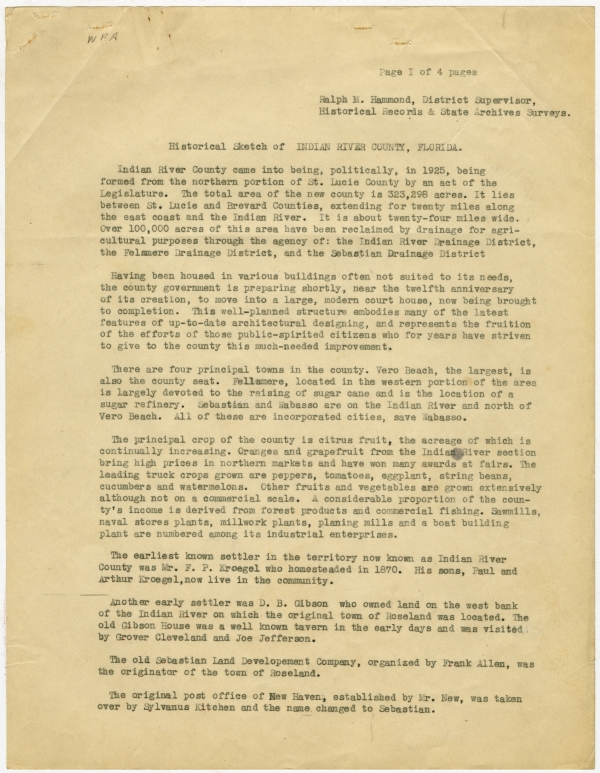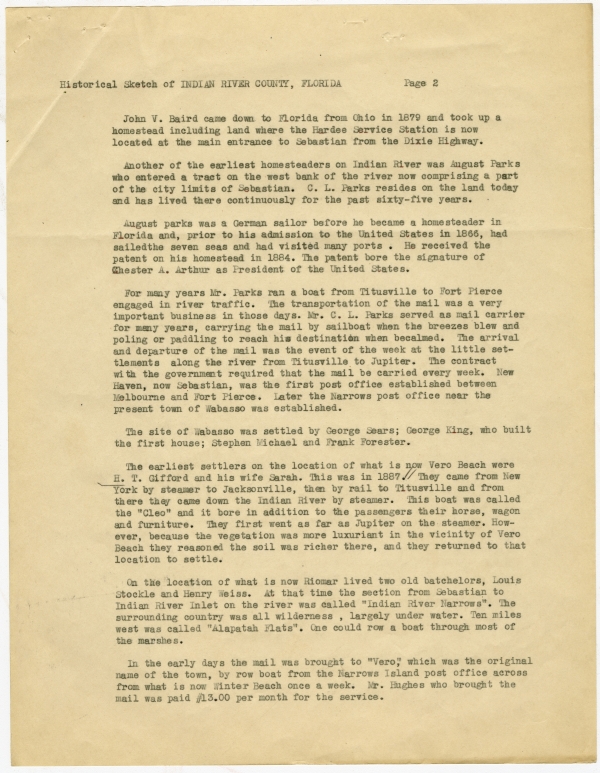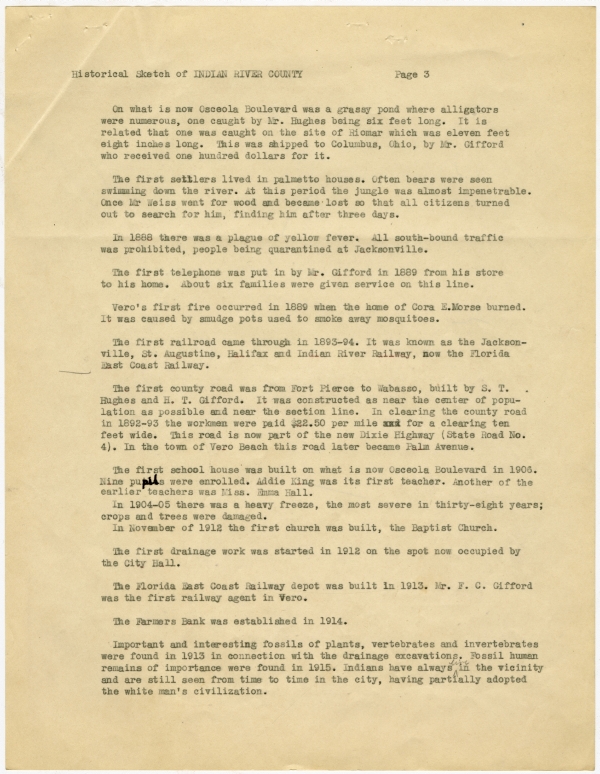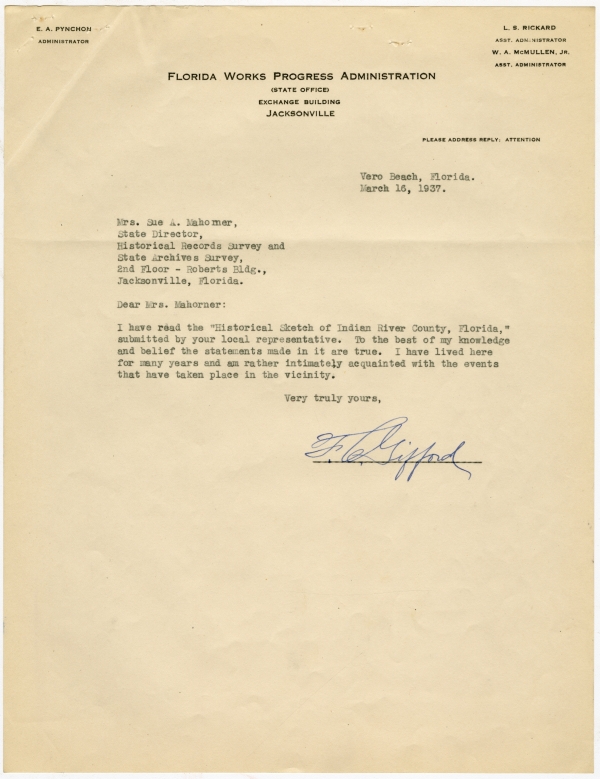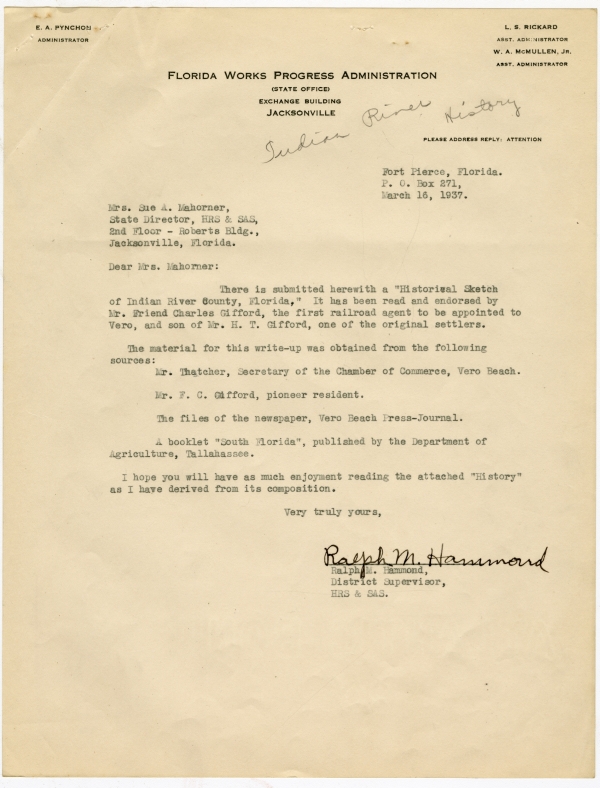Transcript
Page I of 4 pages [sic]
Ralph M. Hammond, District Supervisor,
Historical Records & State Archives Surveys.
Historical Sketch of INDIAN RIVER COUNTY, FLORIDA.
Indian River County came into being, politically, in 1925, being formed from the northern portion of St. Lucie County by an act of the Legislature. The total area of the new county is 323,298 acres. It lies between St. Lucie and Brevard Counties, extending for twenty miles along the east coast and the Indian River. It is about twenty-four miles wide. Over 100,000 acres of this area have been reclaimed by drainage for agricultural purposes through the agency of: the Indian River Drainage District, the Felsmere [sic] Drainage District, and the Sebastian Drainage District
Having been housed in various buildings often not suited to its needs, the county government is preparing shortly, near the twelfth anniversary of its creation, to move into a large, modern court house, now being brought to completion. This well-planned structure embodies many of the latest features of up-to-date architectural designing, and represents the fruition of the efforts of those public-spirited citizens who for years have striven to give to the county this much-needed improvement.
There are four principal towns in the county. Vero Beach, the largest, is also the county seat. Fellsmere, located in the western portion of the area is largely devoted to the raising of sugar cane and is the location of a sugar refinery. Sebastian and Wabasso are on the Indian River and north of Vero Beach. All of these are incorporated cities, save Wabasso.
The principal crop of the county is citrus fruit, the acreage of which is continually increasing. Oranges and grapefruit from the Indian River section bring high prices in northern markets and have won many awards at fairs. The leading truck crops grown are peppers, tomatoes, eggplant, string beans, cucumbers and watermelons. Other fruits and vegetables are grown extensively although not on a commercial scale. A considerable proportion of the county’s income is derived from forest products and commercial fishing. Sawmills, naval stores plants, millwork plants, planing mills and a boat building plant are numbered among its industrial enterprises.
The earliest known settler in the territory now known as Indian River County was Mr. F. P. Kroegel who homesteaded in 1870. His sons, Paul and Arthur Kroegel, now live in the community.
Another early settler was D. B. Gibson who owned land on the west bank of the Indian River on which the original town of Roseland was located. The old Gibson House was a well known tavern in the early days and was visited by Grover Cleveland and Joe Jefferson.
The old Sebastian Land [Development] Company, organized by Frank Allen, was the originator of the town of Roseland.
The original post office of New Haven, established by Mr. New, was taken over by Sylvanus Kitchen and the name changed to Sebastian.
Historical Sketch of INDIAN RIVER COUNTY, FLORIDA
Page 2
John V. Baird came down to Florida from Ohio in 1879 and took up a homestead including land where the Hardee Service Station is now located at the main entrance to Sebastian from the Dixie Highway.
Another of the earliest homesteaders on Indian River was August Parks who entered a tract on the west bank of the river now comprising a part of the city limits of Sebastian. C. L. Parks resides on the land today and has lived there continuously for the past sixty-five years.
August [Parks] was a German sailor before he became a homesteader in Florida and, prior to his admission to the United States in 1866, had [sailed the] seven seas and had visited many ports. He received the patent on his homestead in 1884. The patent bore the signature of Chester A. Arthur as President of the United States.
For many years Mr. Parks ran a boat from Titusville to Fort Pierce engaged in river traffic. The transportation of the mail was a very important business in those days. Mr. C. L. Parks served as mail carrier for many years, carrying the mail by sailboat when the breezes blew and poling or paddling to reach his destination when becalmed. The arrival and departure of the mail was the event of the week at the little settlements along the river from Titusville to Jupiter. The contract with the government required that the mail be carried every week. New Haven, now Sebastian, was the first post office established between Melbourne and Fort Pierce. Later the Narrows post office near the present town of Wabasso was established.
The site of Wabasso was settled by George Sears; George King, who built the first house; Stephen Michael and Frank Forester.
The earliest settlers on the location of what is now Vero Beach were H. T. Gifford and his wife Sarah. This was in 1887. They came from New York by steamer to Jacksonville, then by rail to Titusville and from there they came down the Indian River by steamer. This boat was called the “Cleo” and it bore in addition to the passengers their horse, wagon and furniture. They first went as far as Jupiter on the steamer. However, because the vegetation was more luxuriant in the vicinity of Vero Beach they reasoned the soil was richer there, and they returned to that location to settle.
On the location of what is now Riomar lived two old [bachelors], Louis Stockle and Henry Weiss. At that time the section from Sebastian to Indian River Inlet on the river was called “Indian River Narrows”. The surrounding country was all wilderness, largely under water. Ten miles west was called “Alapatah Flats”. One could row a boat through most of the marshes.
In the early days the mail was brought to “Vero,” which was the original name of the town, by row boat from the Narrows Island post office across from what is now Winter Beach once a week. Mr. Hughes who brought the mail was paid [$]13.00 per month for the service.
Historical Sketch of INDIAN RIVER COUNTY
Page 3
On what is now Osceola Boulevard was a grassy pond where alligators were numerous, one caught by Mr. Hughes being six feet long. It is related that one was caught on the site of Riomar which was eleven feet eight inches long. This was shipped to Columbus, Ohio, by Mr. Gifford who received one hundred dollars for it.
The first settlers lived in palmetto houses. Often bears were seen swimming down the river. At this period the jungle was almost impenetrable. Once Mr Weiss [sic] went for wood and became lost so that all citizens turned out to search for him, finding him after three days.
In 1888 there was a plague of yellow fever. All south-bound traffic was prohibited, people being quarantined at Jacksonville.
The first telephone was put in by Mr. Gifford in 1889 from his store to his home. About six families were given service on this line.
Vero’s first fire occurred in 1889 when the home of Cora E.Morse burned. It was caused by smudge pots used to smoke away mosquitoes.
The first railroad came through in 1893-94. It was known as the Jacksonville, St. Augustine, Halifax and Indian River Railway, now the Florida East Coast Railway.
The first county road was from Fort Pierce to Wabasso, built by S. T. Hughes and H. T. Gifford. It was constructed as near the center of population as possible and near the section line. In clearing the county road in 1892-93 the workmen were paid $22.50 per mile for a clearing ten feet wide. This road is now part of the new Dixie Highway (State Road No. 4). In the town of Vero Beach this road later became Palm Avenue.
The first school house was built on what is now Osceola Boulevard in 1906. Nine pupils were enrolled. Addie King was its first teacher. Another of the earlier teachers was Miss. Emma Hall.
In 1904-05 there was a heavy freeze, the most severe in thirty-eight years; crops and trees were damaged.
In November of 1912 the first church was built, the Baptist Church.
The first drainage work was started in 1912 on the spot now occupied by the City Hall.
The Florida East Coast Railway depot was built in 1913. Mr. F. C. Gifford was the first railway agent in Vero.
The Farmers Bank was established in 1914.
Important and interesting fossils of plants, vertebrates and invertebrates were found in 1913 in connection with the drainage excavations. Fossil human remains of importance were found in 1915. Indians have always [lived] in the vicinity and are still seen from time to time in the city, having partially adopted the white man’s civilization.
Historical Sketch of INDIAN RIVER COUNTY, FLORIDA
Page 4
Orange groves were first planted on the peninsula. Fruit was sent to market wrapped in old newspapers, and packed in home made boxes which were strapped with split willow bands. Lumber was shipped from Titusville by boat and floated ashore here for building purposes.
Indian River County established a Fair Association and held its first County Fair in January, 1926.
The first light plant for Vero was a Delco system which supplied the small hotel and an office or two in 1917. A company was then formed to furnish the community with lights, and steps were taken to build a permanent plan. Mr. Joe Hill was president. The new plant began operation in November, 1917, with forty patrons who were served from dark until eleven o’clock and on Wednesday mornings (so that laundry, etc., could be done) at the rate of eighteen cents per [kilowatt] hour. A twenty-five horse power motor operated the generator.
The city took over the operation of the plant as a municipal utility in November, 1920. The capacity of the plant at that time was 35 k w. It was housed in a small frame shed. The plant was moved to larger quarters in 1921 on the site of the present modern structure. The capacity was increased by the installation of another twenty-five horse power engine. Street lighting was then begun with fifty units along the main [thoroughfare]. Since that time three bond issues totaling $182,600., and a PWA grant and loan have made possible the construction of a modern concrete brick and steel power plant of 2,140 horse power and a production capacity of over 1,500 k w.
The growth of Vero has been gradual. In 1888 there were four families living in the locality; in 1897 the number of families had increased to six; by 1906 there were ten families to be counted.
In 1913 there was a population of eighty-five persons;
In 1915 there were three hundred persons
In 1918 [there were] five [hundred persons]
In 1919 [there were] seven [hundred] and two inhabitants.
The government census of 1920 sets the population at 793 persons.
The state census taken in 1925 showed 1445.
The population today is estimated to exceed 3,000 persons.
The city of Vero was first incorporated with an area of three and one-half miles. A new charter was granted by the State Legislature in 1925, changing the name of the municipality to Vero Beach, and greatly enlarging its area.
E. A. PYNCHON
ADMINISTRATOR
L. S. RICKARD
ASST. ADMINISTRATOR
W. A. MCMULLEN, JR.
ASST. ADMINISTRATOR
FLORIDA WORKS PROGRESS ADMINISTRATION
(STATE OFFICE)
EXCHANGE BUILDING
JACKSONVILLE
PLEASE ADDRESS REPLY: ATTENTION
Vero Beach, Florida.
March 16, 1937.
Mrs. Sue A. Mahorner,
State Director,
Historical Records Survey and
State Archives Survey,
2nd Floor – Roberts Bldg.,
Jacksonville, Florida.
Dear Mrs. Mahorner:
I have read the “Historical Sketch of Indian River County, Florida,” submitted by your local representative. To the best of my knowledge and belief the statements made in it are true. I have lived here for many years and am rather intimately acquainted with the events that have taken place in the vicinity.
Very truly yours,
[signed] F. C. Gifford
E. A. PYNCHON
ADMINISTRATOR
L. S. RICKARD
ASST. ADMINISTRATOR
W. A. MCMULLEN, JR.
ASST. ADMINISTRATOR
FLORIDA WORKS PROGRESS ADMINISTRATION
(STATE OFFICE)
EXCHANGE BUILDING
JACKSONVILLE
Indian River History
PLEASE ADDRESS REPLY: ATTENTION
Fort Pierce, Florida.
P. O. Box 271,
March 16, 1937.
Mrs. Sue A. Mahorner,
State Director, HRS & SAS,
2nd Floor – Roberts Bldg.,
Jacksonville, Florida.
Dear Mrs. Mahorner:
There is submitted herewith a “Historical Sketch of Indian River County, Florida,” It has been read and endorsed by Mr. Friend Charles Gifford, the first railroad agent to be appointed to Vero, and son of Mr. H. T. Gifford, one of the original settlers.
The material for this write-up was obtained from the following sources:
Mr. Thatcher, Secretary of the Chamber of Commerce, Vero Beach.
Mr. F. C. Gifford, pioneer resident.
The files of the newspaper, Vero Beach Press-Journal.
A booklet “South Florida”, published by the Department of Agriculture, Tallahassee.
I hope you will have as much enjoyment reading the attached “History” as I have derived from its composition.
Very truly yours,
[signed] Ralph M. Hammond
Ralph M. Hammond,
District Supervisor,
HRS & SAS.

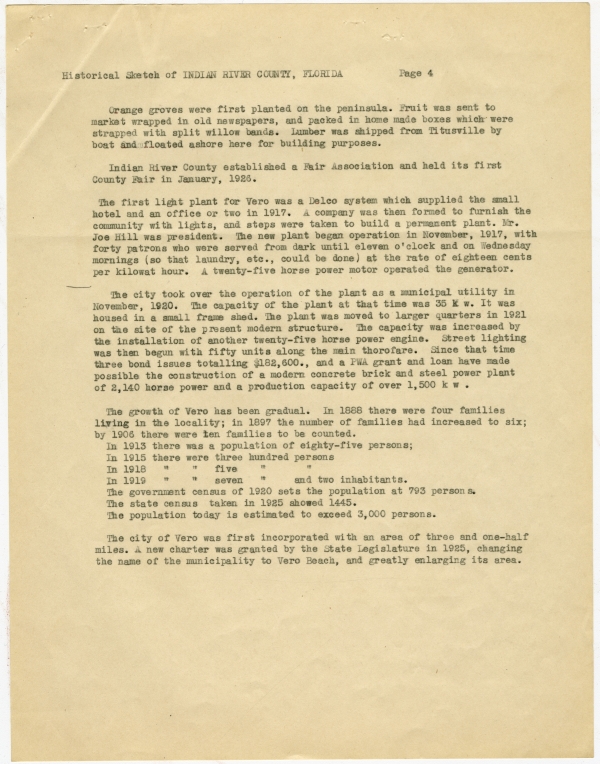


 Listen: The World Program
Listen: The World Program